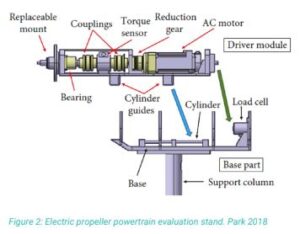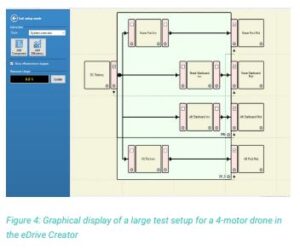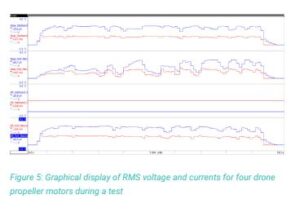Challenges in Testing Electric and More Electric Aircraft Motor and Inverters
INTRODUCTION
In recent years there has been an increased interest in electric and more electric aircraft, including both novel all-electric aircraft, drones, rigid air ships and traditional aircraft with efficient and more electric components. Validating these systems and components has challenges due to the nature of aerospace testing as well as the high level of sophistication of the systems. Aerospace testing requires rigorous reliability testing and validation on all electrical and mechanical systems before planes and components can fly. Many of the technologies that enable the high level of reliability also create technical challenges in both design and measurement. The use of many motors or higher phase count motors will create a higher level of complexity than in land applications. This paper will expand on some of the challenges seen in electric aircraft testing and how HBK’s eDrive system helps overcome these challenges which includes test stand setup, high complexity testing, measurement of high frequency power, electromechanical testing and high voltage testing. The HBK eDrive power analyzer has unique features which make it an ideal measurement system for developing and validating electric aircraft powertrain. The eDrive solution simplifies testing complexity, allows users to test more quickly and gives a high level of traceability to tests. It does this by recording continuous data for large numbers of electrical and mechanical channels, then processes the data in real time to conduct power and efficiency calculations.
MEASUREMENTS REQUIRED FOR AN ELECTRIC PROPELLER EVALUATION
Many early examples of full electric propulsion use one or more electric propellers as a main propulsion source. While many groups look at electric propulsion as a novel method of transportation, others look to justify the efficiency of electric propulsion over their combustion counterparts. To do this, companies need to show a very high level of efficiency for the total powertrain of their aircraft. They will also want to have the maximum efficiency to increase the marketable range of the vehicle. Showing a total efficiency number and having the confidence in this number to fly a plane for a given range will require comprehensive testing on all components in the powertrain. In the case of an electric propeller, this will include one or more inverters, motors, and propellers. The electric powertrain for this type of propulsion can be seen in figure 1. There is an electrical power source that supplies voltage and current to an inverter. The inverter takes AC or DC power and converts it to variable frequency AC voltage and current. While AC power for automotive and industrial applications is often 3 phases, it is becoming very common in aerospace for this to be 6, 9, or more phases for redundancy purposes. This n phase current will supply an electric machine which creates torque and speed which spins
a propeller creating air movement and force. Total efficiency of the system, as well as each of the components, requires measurement of all the above listed parameters.

Propeller efficiency requires a thrust (force) and air movement measurement to calculate propeller power. These measurements will be in addition to the torque, speed, voltages, and currents measured in a standard electric motor test which creates challenges for a measurement system because many systems that measure accurate electrical power, or rotational power cannot acquire in the additional signals necessary for propeller efficiency calculations. Measuring this as a continuous chain with a single device provides the most accurate results due to the time alignment of all signals.
Flexibility and the ability to do a variety of tests is preferred when designing a test stand. A full validation of the electric powertrain will likely include traditional motor validation, consisting of a dynamometer load test, but also validation of the complete propeller efficiency including the propeller and other mechanical components.
 The proposed test stand in figure 2 is intended to perform a full propeller efficiency test; however, it could also be coupled with a traditional load for in-depth motor/inverter analysis. The test stand consists of a rigid support structure to mount the propulsion system, a load cell for measuring the thrust, the motor system, a torque sensor, couplings and mounting brackets and an attachment for either a propeller or load machine. This test stand would have external sensors for n phase currents, direct measurement of voltages and an external sensor for air movement.
The proposed test stand in figure 2 is intended to perform a full propeller efficiency test; however, it could also be coupled with a traditional load for in-depth motor/inverter analysis. The test stand consists of a rigid support structure to mount the propulsion system, a load cell for measuring the thrust, the motor system, a torque sensor, couplings and mounting brackets and an attachment for either a propeller or load machine. This test stand would have external sensors for n phase currents, direct measurement of voltages and an external sensor for air movement.
Additional sensors for temperature, noise or vibration could easily be added. As shown in figure 1 these sensors would come directly into a single eDrive system for simple and organized testing.
ELECTRIC PROPELLER TESTING PROCEDURES
Electric propeller testing includes the characterization of the full operation range of the powertrain in order to properly characterize efficiency, meaning that the full flight cycle of a propeller will need to be correctly characterized to get an accurate range number. The aircraft will also need to deal with disturbances and failures that might occur during the flight. To characterize these different efficiencies and conditions, testing will involve start up, take off, steady state, and possible disturbance events. Each of these states will look at different values. Motor start up examines the dynamics of the machine including efficiency and power used. Steady state evaluates efficiency at different air densities and can reject disturbances.
 Failure testing looks at what happened, why, and how the system performed during the failure. Figure 3 shows an example of a test which incorporated all these states for an electric propeller test. The propeller starts in a very nonlinear fashion as indicated by the nonlinear power at the beginning of the test. The propeller then operates at a steady state condition for a period before having to reject a disturbance. The disturbance is indicated by the dip in all three powers. The test concludes when there is a failure resulting in a propeller shutdown.
Failure testing looks at what happened, why, and how the system performed during the failure. Figure 3 shows an example of a test which incorporated all these states for an electric propeller test. The propeller starts in a very nonlinear fashion as indicated by the nonlinear power at the beginning of the test. The propeller then operates at a steady state condition for a period before having to reject a disturbance. The disturbance is indicated by the dip in all three powers. The test concludes when there is a failure resulting in a propeller shutdown.
This a valuable test for engineers because it shows a continuous measurement of both raw signals and power levels for several minutes. Engineers will have the accurate powers for control events such as start-up and disturbance so they can calibrate and tune their system with a real-world load.
Dynamic power data allows engineers to understand the efficiency throughout a flight. Lastly, having the data for a fault as well as the time period leading up to a fault will help engineers diagnose issues and correct them.
The ability to do all these tests with one system that accurately records all the data for electrical and mechanical signals will greatly simplify the testing procedure. Characterizing full system and dynamic power is not as simple as it may sound due to the nature of power measurements. Power measurements, specifically for efficiency, must be averages made on the same time frame as the AC waves from the inverter. To achieve this,
all mechanical and electrical data needs to be acquired on one timestamp and averaged over the same period. This will be discussed more later.
These types of system level tests allow for the understanding of system level interactions as well as the correct information to make component level optimizations and design changes. System level tests have additional challenges of multiple machine efficiency, the control of multiple machines and characterization of temperatures and vibrations which increases the testing requirements to include a wide variety of inputs and calculations. The eDrive system allows users to continuously measure all these signals for extended periods which speeds up development and simplifies their setups.
SIMPLE SOFTWARE SETUP AND CONFIGURATION FOR SYSTEM TESTING
In addition to a diverse set of signals for measuring electric aircraft propulsion, there are also scenarios where there are a variety of machines or machines with a higher degree of complexity such as gear stages or redundant inverters. Setting up for a test with a higher level of sophistication may require a large amount of integration effort for both hardware and software with more traditional systems. In addition to measuring large channel counts and diverse signals, the eDrive system has sophisticated software for simplifying setup and visualization. A drone is an example of a complex system which has four or more motors and inverters, each with a series of voltages and currents that operate independently. Each motor/inverter has
its own efficiency but also contribute to a subsystem efficiency as well as the total system efficiency which presents challenges as this is a unique powertrain not be used by many and likely does not have an instrument that is set up specifically for this type of configuration or unique subset of component concerns. Beyond pure measurement, users may want a graphical representation of the powertrain to show to managers or customers.
The eDrive system combats these issues by taking in large channel counts to a single data acquisition unit and has a software GUI called eDrive Creator where users can design a unique powertrain configuration. It involves drag and drop blocks that define the powertrain component, inputs and
outputs and defining the efficiencies to be calculated. This makes complex setups with many power stages or power devices easy to analyze. The eDrive creator automatically creates the power and efficiency equations to be computed in real time. In systems with many channels, this will decrease hardware and software configuration, as well as cut down on post processing time.
 Figure 4 shows an example of a test setup for a batterypowered drone with four electric propellers that was instrumented to look at controller function and efficiency. The drone’s battery power is sent to four inverters, converts the DC power to AC power for four motors. In this test the engineers wanted to characterize the power and efficiency during a drone take off sequence. To do this they needed to measure the power and efficiency of each inverter/motor pair as well as the total system efficiency. The eDrive Creator window shows each powertrain component, its name, and the total
Figure 4 shows an example of a test setup for a batterypowered drone with four electric propellers that was instrumented to look at controller function and efficiency. The drone’s battery power is sent to four inverters, converts the DC power to AC power for four motors. In this test the engineers wanted to characterize the power and efficiency during a drone take off sequence. To do this they needed to measure the power and efficiency of each inverter/motor pair as well as the total system efficiency. The eDrive Creator window shows each powertrain component, its name, and the total
system efficiency which provides easy feedback to the user. When a user clicks on one or more of the blocks, they will see a display area where they can view the individual signals for that component.
Figure 5 is an example of a quad copter take off with one machine not functioning. We see the RMS voltage and current increase for 3 of the channels. Two of the propellers are stable with some dynamics and the third is very dynamic trying to compensate for the failed machine. Tests like this provide
insight on how a system controller functions during normal operation or failure.
 Complex tests like the quad copter require visualizations and recording like any other test. Once a configuration has been set, the equations are deployed and executed during the next test. All the recorded data and real time calculated data is stored, for as long as there is hard disk space, which allows users to execute and view full tests for things like system dynamics without any drops in data or trigger events needed.
Complex tests like the quad copter require visualizations and recording like any other test. Once a configuration has been set, the equations are deployed and executed during the next test. All the recorded data and real time calculated data is stored, for as long as there is hard disk space, which allows users to execute and view full tests for things like system dynamics without any drops in data or trigger events needed.
These displays give the user real time feedback on what is happening in their test and the ability to look back after the test is finished for review and validation. This functionality is native to the eDrive software and allows users to frequently change test setups without having to invest large efforts into reconfiguring test computers.
VISUALIZATION AND FEEDBACK OF DATA IN REAL TIME
Visualizing and storing real time calculated data is a necessity for modern tests. For this reason, the eDrive system utilizes a Real Time Formula Database (RTFDB) which executes all equations in discrete time on a DSP. After the power, efficiency, control and other equations are run in real time hey are stored and are available for visualization and feedback which minimizes post process analysis time, eliminates display lag and enables feedback to automation systems for fully automated testing or HIL simulations. In the example above, propeller efficiency can be taken directly from measurements or from a combination of calculations and measurements. The RTFDB uses sensor inputs, constants and equations to display and record any value. The DSP can be accessed by the user to define their own custom equations. This also adds the capability of the test data to be
broadcast the data over EtherCAT or CAN bus for real time feedback to an automation system. Having real time feedback in a test stand allows the operator to demonstrate and execute the variety of tests listed above as well as HIL.In combination with the measured rotational power, AC electric power and DC electric power, an engineer can look at the efficiency of an entire system or the individual components with one test and one system.
HIGH FUNDAMENTAL FREQUENCY POWER TESTING
There is a trend in electrification to go to higher pole counts and higher fundamental frequencies creating a challenge for power measurements since historic devices have been tuned and rated for 50-60hz. This is not enough for many applications in aerospace that are in the hundreds of Hz or kHz. The eDrive system solves this problem of high fundamental measurement with the cycle detect algorithm which can handle fundamental frequencies into the 10’s of kHz range. Collecting the measureents cycle by cycle also allows for accurate power calculations, even if the frequency is changing. This becomes particularly important for fan testing, as there is no load machine fixing the speed. An example of a higher frequency test with a moving fundamental frequency is shown in figure 6 where the motor fundamental is moving between 345 and 350 Hz. The cycle detect algorithm filters the current in the DSP and determines zero crossing points. It uses these zero crossings to determine the half cycle time which is used for the power and efficiency calculations. This is done in real time, at the half cycle rate, on the DSP. Having calculations on the half cycle allows for accurate dynamic testing or averaging for very high-resolution steady state efficiency measurements even if the fundamental frequency is not static.

The eDrive system also has the added benefit of recording all the instantaneous data so that users can be confident in their results and replicate them if needed. If there are issues with the test the recorded data is a method of troubleshooting and allows users to re-run the tests in software, rather than wasting time and resources to re-run a test.
ELECTROMECHANICAL AIRCRAFT TESTING
Mechanical output can take many forms for electric propulsion testing. It can be the thrust and air movement created by a propeller, the noise emissions from the machine or the vibration pattern of the aircraft. Knowing how electrical phenomena interact with mechanical outputs is of value to the design engineers for powertrain, NVH, reliability and durability. Vibration is an important measurement in aircraft propulsion test stands. Different speeds and loadings will result in different amounts of vibration. Inverter switching and control strategy will also influence vibration of the motor which adds to the need to correlate vibration, torque and PWM signals. Accelerometers can also help determine what the influence
of failures or inverter control changes will be on the structure of the system. The eDrive system can record all the accelerometers and other mechanical signals, while also giving a very accurate power measurement. For this reason, eDrive system is the right solution to perform multiple tests simultaneously.
Accelerometers can also help determine what the influence of failures or inverter control changes will be on the structure of the system. The eDrive system can record all the accelerometers and other mechanical signals, while also giving a very accurate power measurement. For this reason, eDrive system is the right solution to perform multiple tests simultaneously.
Figure 7 shows an example of a fan motor under test incorporating V, I, force, and vibration on a common graph. This demonstrates NVH, and powertrain tests running at the same time, correlated for an aircraft type test. Both NVH and powertrain groups have access to full data sets to understand why issues are happening and the conditions throughout their tests.

HIGH VOLTAGE
Raising the voltage level of systems is appealing due to the reduction in currents and associated losses. The downside of higher voltages is that there are altitude effects as well as a variety of safety concerns. HBK has a long history measuring high voltage, and high voltage transient signals from extensive work in switch gear and lighting impulse tests. These tests become challenging due to issues with human safety, equipment safety, accuracy and noise. With various techniques based on voltage level, an eDrive system can safely and accurately make these measurements which can be used for power calculations as previously discussed or the analysis of transients such as lightning impulses or corona discharge. One of the unique features for high voltage is a fiber optic solution which digitizes at the measurement and transmits over fiber optic cable back to the data acquisition system. This makes the system safe for the operator, equipment and provides a high level of noise immunity.
CONCLUSION
Electric aircraft testing has unique challenges including the level of complexity, number of measurements, and the variety of signals. In addition to the number of signals electric aircraft also pushes the limits of technology by going to higher voltages and frequencies. Making measurements, simply,
quickly, and accurately can be accomplished using the HBK eDrive.
SOURCES
Park, D., Lee, Y., Cho, T., & Kim, C. (2018). Design and Performance Evaluation of Propeller for Solar-Powered High-Altitude Long-Endurance Unmanned Aerial Vehicle. International Journal of Aerospace Engineering, 2018, 1–24.



